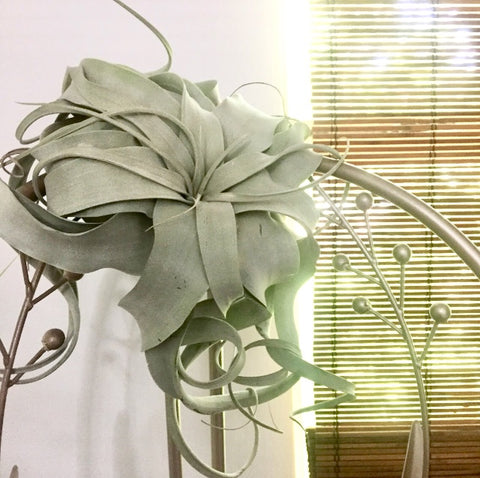
Winterizing Your Air Plants
As the weather gets colder, it’s now time to move which ever air plants you have kept outdoors into your home! Air Plants are from tropical climates so if you live up north, it will likely be necessary to bring your plants inside for the winter months. Once the nights start falling into the 40s Farenheit, air plants should be moved indoors.
Over the summer months, your air plants received more light and higher humidity than they will during the winter. As we move them indoors, their environment will be changing in a short period of time which can put some stress on the plants. In order to cause your air plants as little stress as possible as you move them indoors, we have a few tips to help!
Temperature changes will not be too drastic for your air plants as you will be moving them inside your home where the temperature is controlled. You shouldn't be too concerned with the temperature of your home, because as long as you keep it between 55 and 85 degrees (likely for most people), your plants will be fine. It is more the change from humidity to dryness, and less sunshine, that can affect your plants and cause them some problems.

Just be aware that if you use a heater, fireplace, wood stove, etc., the air will be a little drier. Make sure you do not place your air plants too close to the fireplace as the heat and embers can be damaging. Forced air heating can be damaging as well, so just be sure to not put your plants directly in the way of any warm air flow. Also make sure that your air plants are in an area that gets some indirect sunlight.
The dryness can be detrimental to your air plants if you do not combat it with mistings. Continue with your normal water cycle, and just add in an extra misting. You can spray directly onto the plant, or do an air misting. Air misting is a little different than plant misting. Instead of spraying directly on the plant, just mist the air right around it to help add some humidity back into the air. Adding humidity into the air can also be done by placing some decorative bowls or shells filled with water around the plants to help with the dryness.
Another way to combat winter dryness is to decorate your bathroom with your air plants, allowing that is has bright natural light. Air plants make beautiful bathroom décor and they will get a good blast of humidity any time that someone takes a shower. You can find some pretty vases to place on your bathroom counter, or on some shelves. Another nice option is to set up a vertical garden on your bathroom walls with cork bark, a piece of wood, or any other object that you would like to cover with air plants! Just remember that a weekly soaking/watering will still be necessary even though they will get dampened from the shower humidity.
It is also important to consider sources for natural light in your home. Dark rooms, corridors or shelving are not ideal spots for winter survival. In the winter, you do not need to completely avoid direct sunlight, since the sun is a lot weaker and days are shorter. Try to give your air plants at least 5 hours of the winter's brightest light per day. Try to locate your air plants within 10 feet of windows.
Make sure to not to worry too much about the transition from outdoor to indoor because as long as you keep an eye on all of your plants, especially in the beginning as you are figuring out your new watering schedule, you should be able to catch any problems early enough to fix them! For example, if you see curling leaves or dry tips, this is a sign your air plants may need a little more moisture. Just inspect them often and adjust your watering accordingly. If you are watering once a week, just up it to twice a week, in addition to your mistings, and see if that helps. If they don’t respond well enough to that change after a week or two, it could be that they are not getting enough indirect sunlight. Just try moving them to a better spot and they should improve!
Other winter considerations:
Fireplaces. Make sure your plants are a good distance from the heat and embers of your fireplace.
Air Circulation. Your plants need to have air enough to dry them after watering but should not be placed too close to a heater duct.
Light. Bright light is important and if can't be supplied naturally then by all means use artificial lighting. Do not place your air plants too close to an incandescent bulb though and please read my article on Indoor Lighting. Also, please do not place your air plants in your Christmas Tree. The lights on the tree are hot and will burn your plants.













Leave a comment